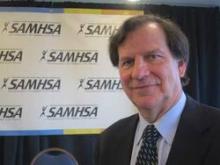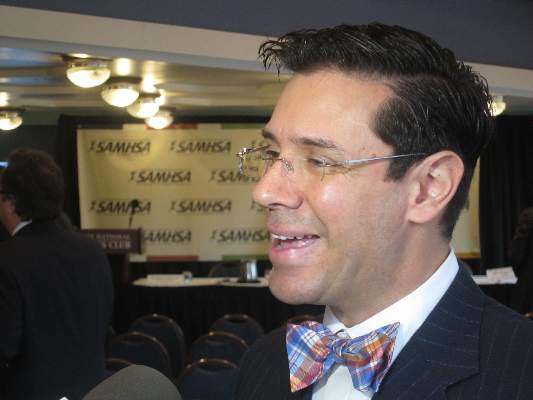User login
WASHINGTON – Primary care providers are being urged by a federal agency to heighten their sensitivities to patients at risk for suicide.
Citing data that nearly half of all persons who died by suicide had seen a primary care provider within the month prior to their death, Pamela S. Hyde, J.D., administrator of the Substance Abuse and Mental Health Services Administration, overseen by the U.S. Department of Health & Human Services, today announced the launch of the Suicide Safe app, a free risk-assessment tool for providers to screen patients at risk for suicide.
According to Ms. Hyde, who spoke during a SAMHSA news briefing, suicide is the leading cause of death in the United States among those aged 15-29 years, with one person dying of suicide every 13 minutes. Ms. Hyde also noted that suicide was seen to trend upward between the years 1999 and 2010 when the age-adjusted suicide rate for people aged 35-64 years increased 28%.
“Our offices are the key access points where we can start to identify these patients,” said Dr. Fabian Sandoval, a Washington-based researcher and clinical protocols consultant who spoke at the news briefing. “But we are not the experts, we are not the psychiatrists, so what are we going to do?”
Dr. Sandoval said the tool would support the generations of primary care providers, including advance practice nurses and physician assistants, who did not receive any formal mental or behavioral health care training, which he said was most of the “old guard” in medicine.
Based on the SAFE-T (Suicide Assessment Five-Step Evaluation and Triage) protocols developed by Dr. Douglas Jacobs of the department of psychiatry at Harvard Medical School, Boston, and the chair of the American Psychiatric Association Practice Guidelines on Suicide, the app helps identify at-risk patients and find local facilities where patients can be referred for emergent or other treatment.
“If I am a primary care provider who doesn’t feel adequately prepared to deal with a patient in the middle of a suicidal crisis, I can use the treatment locator to find a specialized behavioral health provider within a certain radius and immediately link to that person right off the app and get that patient in for an appointment or an emergency visit,” Robert Carrol, an advanced practice registered nurse and a member of the app’s research and development team, said in an interview.
“It’s a tool that can bridge that gap of fear that often prevents providers from even opening the conversation. That’s always the first challenge, providers not wanting to ‘go there’ because they don’t want to answer a question that they won’t know how to answer or respond to.”
Starting the conversation in an open-ended way is crucial to getting a patient to speak honestly about his or her condition, Dr. Mitra Ahadpour, a primary care physician from Germantown, Md., and a clinical communications consultant with SAMHSA, said in an interview. “The open-ended question prompts in the app are very important. We have research that shows closed-ended questions turn the patient off, questions such as ‘You’re not thinking of killing yourself, are you?’ Instead, keep it very simple. Ask, ‘How are you doing today? Then take a second to see what they say.”
Even if primary care physicians are willing to ask and respond to their patients in acute danger of suicide, there is still the need to ensure that even if patients are referred to the appropriate facility, that there is enough room to accommodate them, according to Dr. Sandoval. “We’ll be able to identify more patients who are in suicidal situations than before, but now what? What do we do with this patient? That is a question we have to [address] as well.”
Incorporating the app into clinical practice should not be difficult and could even help encourage a physician to treat the patient him- or herself if the risk for suicide is found to be low, according to Dr. Ahadpour. “There are many points in the system where the app can be integrated. The PHQ-9 (patient health questionnaire that screens for depression) is included in the app, and you can have your patients fill that out ahead of time,” Dr. Ahadpour, who was not on the news briefing panel, said in an interview. “That way the clinician will already know if there is a need to take things to the second step or [assess] for a suicidal risk. If the provider feels comfortable that there is no risk for suicide, then they can treat the patient for depression, for example.” If they do not feel comfortable treating the patient, then “at least they have assessed the patient,” she added. Validated evaluation tools for other mental health conditions, including one for general anxiety disorder are also included in the app, Dr. Ahadpour said. Depression and anxiety are two major risk factors for suicidal ideation.
When asked by a reporter about how primary care physicians should bill their time for using the app, Mr. Carroll said the app included IDC-9 and ICD-10 codes.
For more information about the app, visit SAMHSA’s website.
Dr. Jacobs said the app is freely available at any smart phone app store.
On Twitter @whitneymcknight
WASHINGTON – Primary care providers are being urged by a federal agency to heighten their sensitivities to patients at risk for suicide.
Citing data that nearly half of all persons who died by suicide had seen a primary care provider within the month prior to their death, Pamela S. Hyde, J.D., administrator of the Substance Abuse and Mental Health Services Administration, overseen by the U.S. Department of Health & Human Services, today announced the launch of the Suicide Safe app, a free risk-assessment tool for providers to screen patients at risk for suicide.
According to Ms. Hyde, who spoke during a SAMHSA news briefing, suicide is the leading cause of death in the United States among those aged 15-29 years, with one person dying of suicide every 13 minutes. Ms. Hyde also noted that suicide was seen to trend upward between the years 1999 and 2010 when the age-adjusted suicide rate for people aged 35-64 years increased 28%.
“Our offices are the key access points where we can start to identify these patients,” said Dr. Fabian Sandoval, a Washington-based researcher and clinical protocols consultant who spoke at the news briefing. “But we are not the experts, we are not the psychiatrists, so what are we going to do?”
Dr. Sandoval said the tool would support the generations of primary care providers, including advance practice nurses and physician assistants, who did not receive any formal mental or behavioral health care training, which he said was most of the “old guard” in medicine.
Based on the SAFE-T (Suicide Assessment Five-Step Evaluation and Triage) protocols developed by Dr. Douglas Jacobs of the department of psychiatry at Harvard Medical School, Boston, and the chair of the American Psychiatric Association Practice Guidelines on Suicide, the app helps identify at-risk patients and find local facilities where patients can be referred for emergent or other treatment.
“If I am a primary care provider who doesn’t feel adequately prepared to deal with a patient in the middle of a suicidal crisis, I can use the treatment locator to find a specialized behavioral health provider within a certain radius and immediately link to that person right off the app and get that patient in for an appointment or an emergency visit,” Robert Carrol, an advanced practice registered nurse and a member of the app’s research and development team, said in an interview.
“It’s a tool that can bridge that gap of fear that often prevents providers from even opening the conversation. That’s always the first challenge, providers not wanting to ‘go there’ because they don’t want to answer a question that they won’t know how to answer or respond to.”
Starting the conversation in an open-ended way is crucial to getting a patient to speak honestly about his or her condition, Dr. Mitra Ahadpour, a primary care physician from Germantown, Md., and a clinical communications consultant with SAMHSA, said in an interview. “The open-ended question prompts in the app are very important. We have research that shows closed-ended questions turn the patient off, questions such as ‘You’re not thinking of killing yourself, are you?’ Instead, keep it very simple. Ask, ‘How are you doing today? Then take a second to see what they say.”
Even if primary care physicians are willing to ask and respond to their patients in acute danger of suicide, there is still the need to ensure that even if patients are referred to the appropriate facility, that there is enough room to accommodate them, according to Dr. Sandoval. “We’ll be able to identify more patients who are in suicidal situations than before, but now what? What do we do with this patient? That is a question we have to [address] as well.”
Incorporating the app into clinical practice should not be difficult and could even help encourage a physician to treat the patient him- or herself if the risk for suicide is found to be low, according to Dr. Ahadpour. “There are many points in the system where the app can be integrated. The PHQ-9 (patient health questionnaire that screens for depression) is included in the app, and you can have your patients fill that out ahead of time,” Dr. Ahadpour, who was not on the news briefing panel, said in an interview. “That way the clinician will already know if there is a need to take things to the second step or [assess] for a suicidal risk. If the provider feels comfortable that there is no risk for suicide, then they can treat the patient for depression, for example.” If they do not feel comfortable treating the patient, then “at least they have assessed the patient,” she added. Validated evaluation tools for other mental health conditions, including one for general anxiety disorder are also included in the app, Dr. Ahadpour said. Depression and anxiety are two major risk factors for suicidal ideation.
When asked by a reporter about how primary care physicians should bill their time for using the app, Mr. Carroll said the app included IDC-9 and ICD-10 codes.
For more information about the app, visit SAMHSA’s website.
Dr. Jacobs said the app is freely available at any smart phone app store.
On Twitter @whitneymcknight
WASHINGTON – Primary care providers are being urged by a federal agency to heighten their sensitivities to patients at risk for suicide.
Citing data that nearly half of all persons who died by suicide had seen a primary care provider within the month prior to their death, Pamela S. Hyde, J.D., administrator of the Substance Abuse and Mental Health Services Administration, overseen by the U.S. Department of Health & Human Services, today announced the launch of the Suicide Safe app, a free risk-assessment tool for providers to screen patients at risk for suicide.
According to Ms. Hyde, who spoke during a SAMHSA news briefing, suicide is the leading cause of death in the United States among those aged 15-29 years, with one person dying of suicide every 13 minutes. Ms. Hyde also noted that suicide was seen to trend upward between the years 1999 and 2010 when the age-adjusted suicide rate for people aged 35-64 years increased 28%.
“Our offices are the key access points where we can start to identify these patients,” said Dr. Fabian Sandoval, a Washington-based researcher and clinical protocols consultant who spoke at the news briefing. “But we are not the experts, we are not the psychiatrists, so what are we going to do?”
Dr. Sandoval said the tool would support the generations of primary care providers, including advance practice nurses and physician assistants, who did not receive any formal mental or behavioral health care training, which he said was most of the “old guard” in medicine.
Based on the SAFE-T (Suicide Assessment Five-Step Evaluation and Triage) protocols developed by Dr. Douglas Jacobs of the department of psychiatry at Harvard Medical School, Boston, and the chair of the American Psychiatric Association Practice Guidelines on Suicide, the app helps identify at-risk patients and find local facilities where patients can be referred for emergent or other treatment.
“If I am a primary care provider who doesn’t feel adequately prepared to deal with a patient in the middle of a suicidal crisis, I can use the treatment locator to find a specialized behavioral health provider within a certain radius and immediately link to that person right off the app and get that patient in for an appointment or an emergency visit,” Robert Carrol, an advanced practice registered nurse and a member of the app’s research and development team, said in an interview.
“It’s a tool that can bridge that gap of fear that often prevents providers from even opening the conversation. That’s always the first challenge, providers not wanting to ‘go there’ because they don’t want to answer a question that they won’t know how to answer or respond to.”
Starting the conversation in an open-ended way is crucial to getting a patient to speak honestly about his or her condition, Dr. Mitra Ahadpour, a primary care physician from Germantown, Md., and a clinical communications consultant with SAMHSA, said in an interview. “The open-ended question prompts in the app are very important. We have research that shows closed-ended questions turn the patient off, questions such as ‘You’re not thinking of killing yourself, are you?’ Instead, keep it very simple. Ask, ‘How are you doing today? Then take a second to see what they say.”
Even if primary care physicians are willing to ask and respond to their patients in acute danger of suicide, there is still the need to ensure that even if patients are referred to the appropriate facility, that there is enough room to accommodate them, according to Dr. Sandoval. “We’ll be able to identify more patients who are in suicidal situations than before, but now what? What do we do with this patient? That is a question we have to [address] as well.”
Incorporating the app into clinical practice should not be difficult and could even help encourage a physician to treat the patient him- or herself if the risk for suicide is found to be low, according to Dr. Ahadpour. “There are many points in the system where the app can be integrated. The PHQ-9 (patient health questionnaire that screens for depression) is included in the app, and you can have your patients fill that out ahead of time,” Dr. Ahadpour, who was not on the news briefing panel, said in an interview. “That way the clinician will already know if there is a need to take things to the second step or [assess] for a suicidal risk. If the provider feels comfortable that there is no risk for suicide, then they can treat the patient for depression, for example.” If they do not feel comfortable treating the patient, then “at least they have assessed the patient,” she added. Validated evaluation tools for other mental health conditions, including one for general anxiety disorder are also included in the app, Dr. Ahadpour said. Depression and anxiety are two major risk factors for suicidal ideation.
When asked by a reporter about how primary care physicians should bill their time for using the app, Mr. Carroll said the app included IDC-9 and ICD-10 codes.
For more information about the app, visit SAMHSA’s website.
Dr. Jacobs said the app is freely available at any smart phone app store.
On Twitter @whitneymcknight



